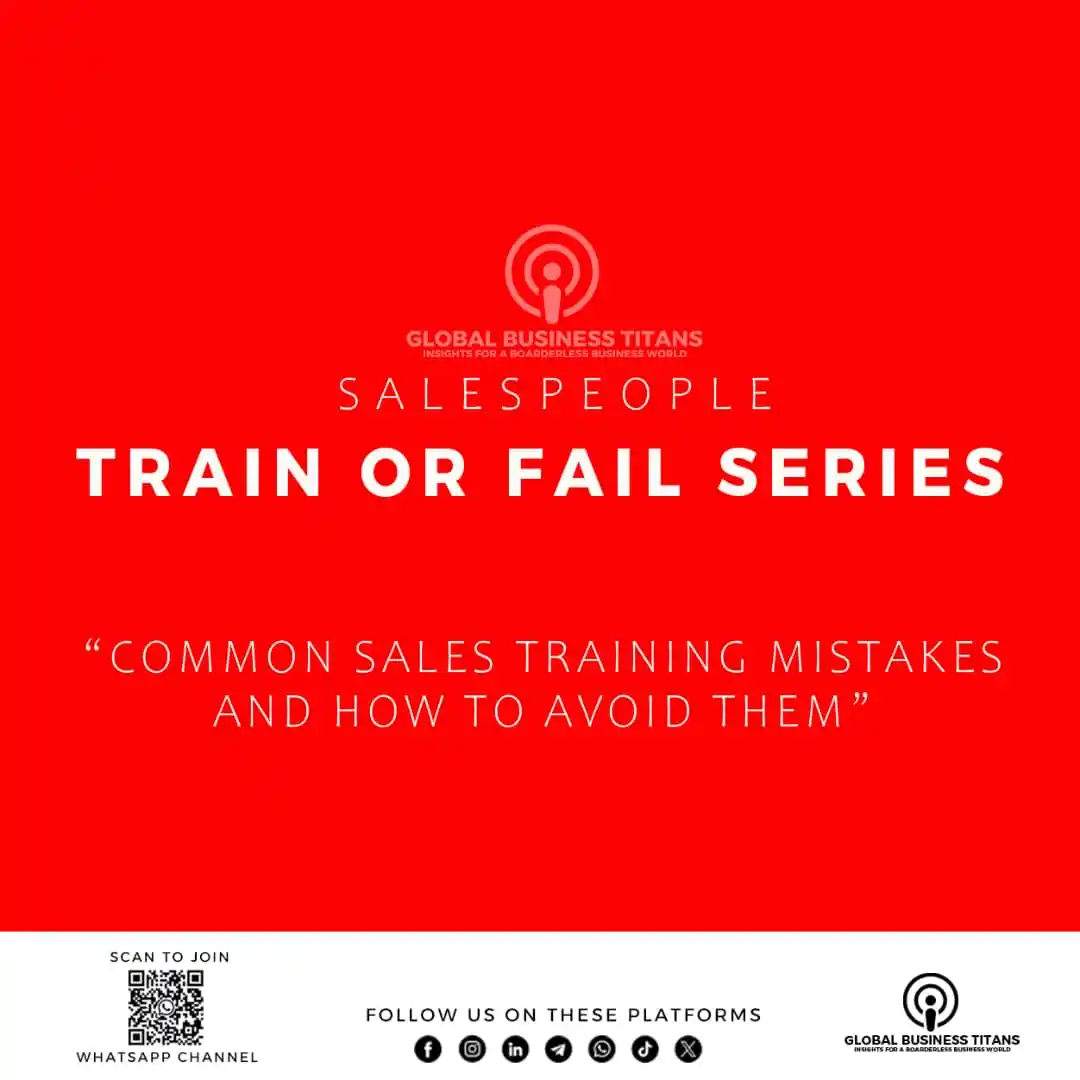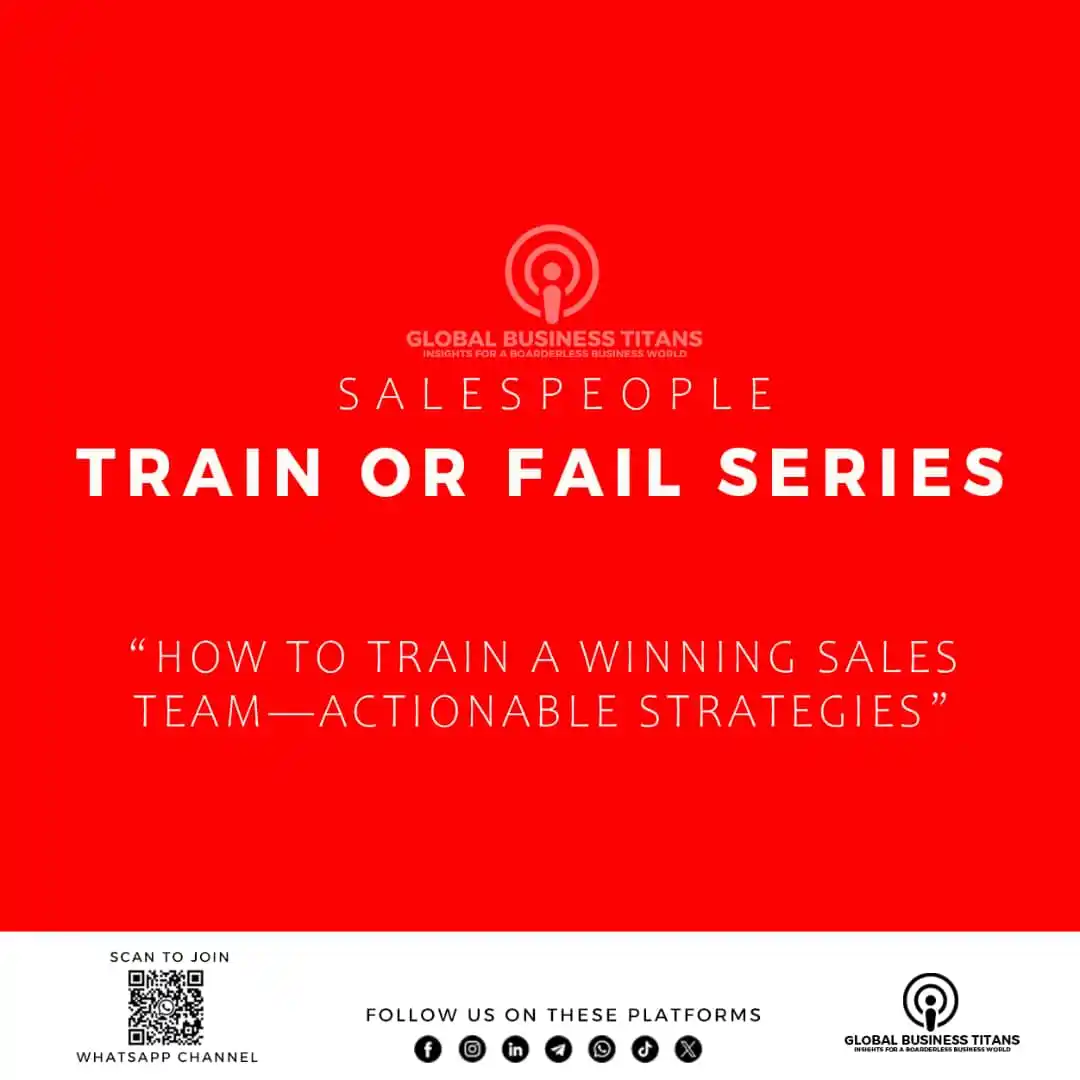
Global Business Titans
154 subscribers
About Global Business Titans
Welcome to Global Business Titans, the podcast channel that dives deep into the world of business. From starting a business to navigating failures, uncovering success stories, and improving sales, marketing, HR, and more, we bring you real stories and actionable strategies. Join us to explore the triumphs and trials of entrepreneurs worldwide, and learn how to conquer your business challenges.
Similar Channels
Swipe to see more
Posts

COMMON SALES TRAINING MISTAKES AND HOW TO AVOID THEM DAY 5 : "TRAIN OR FAIL SERIES" Sales training isn’t a magic bullet. It’s an ongoing process. But if you make the wrong moves, your training will fall flat. Let’s look at some of the most common mistakes—and how to avoid them. 1. OVERLOADING YOUR TEAM WITH INFORMATION It's tempting to throw everything at your team in one go—product knowledge, market trends, objection-handling techniques, closing strategies. But this leads to information overload. Mistake: Trying to teach everything at once. Solution: Focus on one core topic at a time. Give your team enough to practice and apply before moving on. For example, spend a week on handling objections, then the next week on qualifying leads. Gradually build up their skills without overwhelming them. Why: Sales is learned through repetition, not a crash course. 2. SKIPPING THE BASICS Sometimes, sales training focuses too much on advanced techniques and misses the fundamentals. Mistake: Ignoring the basics. Solution: Start with the fundamentals—things like effective questioning, active listening, and understanding the buyer’s needs. Without these, even the most advanced techniques won’t work. Why: Salespeople need a strong foundation to build upon. You can’t teach closing techniques if they don’t know how to build rapport first. 3. FOCUSING ONLY ON PRODUCT FEATURES It’s easy to get caught up in product features. After all, you believe in your product, and you want your team to know it inside and out. But the reality is that buyers don’t care about features unless they understand how it solves their problem. Mistake: Focusing too much on product features. Solution: Train your team to focus on benefits, not just features. They should be able to explain how the product improves the buyer’s situation. Build your sales training around value-based selling. Why: People don’t buy products; they buy solutions to their problems. 4. TREATING SALES TRAINING LIKE AN EVENT Sales training should never be treated as a one-off event. It needs to be consistent, just like any other skill development. Mistake: Thinking sales training is a one-time event. Solution: Make training ongoing. Have short weekly sessions, monthly skill refreshers, and quarterly performance reviews. Embed training into your team’s routine, so they don’t forget and can continually improve. Why: Sales techniques need constant reinforcement to stick. Skills must be honed over time, not just memorized once. 5. NOT MEASURING IMPACT How do you know your training is working? If you’re not measuring the impact, you don’t. Mistake: Not tracking the results of sales training. Solution: Set clear KPIs (Key Performance Indicators) and track them regularly. Whether it’s the number of qualified leads, conversion rates, or deal size, tie these metrics to your training efforts. Why: Without tracking, it’s impossible to know if your training is improving sales performance. QUICK RECAP OF THE MOST COMMON MISTAKES: 1. Overloading with information – Stick to one key topic at a time. 2. Skipping the basics – Start with core skills like questioning and listening. 3. Focusing on product features – Teach value-based selling. 4. Treating training as an event – Make it ongoing. 5. Not measuring impact – Track KPIs tied to training outcomes. What You Should Do Now Look at your current sales training. Are you making any of these mistakes? If so, it’s time to adjust. Training isn’t a quick fix—it’s a long-term investment. Tomorrow, we’ll talk about how to make sales training more engaging and fun, so your team stays motivated and learns faster. Don’t read through this series alone, invite your business owners, sales managers and salespeople. The time to grow your sells and to sell more is now. Regards, Sir. E. Nkala Global Business Titans +263 771 425 334 WhatsApp Channel Link : https://whatsapp.com/channel/0029VaXurQQF1YlNWCHGRD1g


S A L E S P E O P L E "Train or Fail"

If you haven't invited someone to join the channel, right now is the best time send them the link: https://whatsapp.com/channel/0029VaXurQQF1YlNWCHGRD1g

S A L E S P E O P L E "Train or Fail" #salesjobs #salespeople #salestraining

MAKING SALES TRAINING FUN AND ENGAGING DAY 6 : “TRAIN OR FAIL” Sales training doesn’t have to feel like a chore. In fact, it shouldn’t. The more engaged your team is, the more they’ll retain—and the better they’ll perform. Here’s how to make sales training fun, engaging, and effective. 1. Gamify the Learning Process Gamification is a powerful tool for increasing motivation. It turns learning into a challenge, making your team more invested in the process. What to do: • Create friendly competitions: Best objection handler of the month gets a reward. • Use points or badges for completing training modules. • Set up leaderboards to track individual and team progress. Why: People love to compete, especially if there’s a reward or recognition involved. Gamification creates an environment where your team stays motivated and sharp. 2. Use Real-Life Scenarios Nothing beats real-life practice. Instead of teaching generic case studies, use actual situations your salespeople are dealing with. What to do: • Role-play real-world objections your team faces. • Ask them to practice difficult conversations they’ve had with prospects. • Involve the entire team in reviewing common problems and their solutions. Why: Real scenarios make training immediately applicable. It gives your team the confidence they need when faced with real buyers. 3. Keep Sessions Short and Interactive Long, drawn-out training sessions are a sure way to lose engagement. Instead, break up training into smaller, more interactive sessions. What to do: • Host 20-30 minute training sessions—long enough to teach, short enough to keep attention. • Make every session interactive with Q\&A, discussions, and hands-on activities. • Use polls and quizzes during sessions to keep the energy high. Why: People have short attention spans. By keeping things concise and interactive, your team will stay focused and energized. 4. Use Multimedia Content Mix up your training formats to keep it interesting. Videos, podcasts, infographics, and articles can make a huge difference in engagement. What to do: • Create a library of quick, on-the-go training videos your team can access anytime. • Use podcasts or interviews with industry experts as learning tools. • Create visual content like charts or infographics for easy understanding. Why: Different formats appeal to different learning styles. Some people retain information better through video, others through text or audio. Offering variety ensures your team absorbs the content effectively. 5. Celebrate Small Wins Celebrating progress—even small wins—keeps the motivation going. Sales training shouldn’t just be about learning; it should also be about recognizing growth. What to do: • Praise your team’s improvements in front of the group. • Share success stories where the team applied new training techniques to close a deal. • Set up mini-rewards for reaching milestones, like booking a certain number of calls or closing a set number of deals. Why: Celebrating progress reinforces good behavior and builds confidence. It also fosters a positive, competitive environment. Making It Stick Fun doesn’t mean irrelevant. The key is to make your sales training enjoyable without compromising on value. So, what do you think—are you ready to transform your sales training into something your team actually looks forward to? If you are, start with these strategies. They’ll keep your team motivated, focused, and, most importantly, performing better. Let’s Transform Your Sales Team This is the final episode in our series—but it’s only the beginning for you. If you’ve been following along and see the potential of turning your sales team into a motivated, high-performing unit, now is the time to take action. Whether you're a business owner, team leader, or executive—customized sales training can be the game-changer your team needs. Don’t let training be just another checkbox. Let’s make it a strategic asset. Ready to create a sales culture that wins? Reach out today and let’s discuss a tailored sales training solution that fits your organization’s goals, challenges, and industry. Contact Sir. E. Nkala Call/WhatsApp: +263 771 425 334 Email: [email protected] Let’s build a team that doesn’t just sell—but sells with purpose, energy, and impact.


HOW TO TRAIN A WINNING SALES TEAM—ACTIONABLE STRATEGIES DAY 4 : TRAIN OR FAIL SERIES You don’t need a fancy budget to build a better sales team. You need structure, consistency, and relevance. Here’s a clear plan to apply sales training that actually works. 1. START WITH REALITY, NOT THEORY Don’t train people on ideal buyer journeys that never happen. Train them on your sales environment. What to do: • Record real sales calls. Review them in sessions. • Collect the top 10 objections your team hears—train for those weekly. • Build training around your products, your customers, and your challenges. Why: Theory is easy to forget. Context sticks. 2. MAKE TRAINING PART OF THE JOB, NOT A ONE-TIME EVENT If your team only trains when there’s a problem, you’re too late. What to do: • Set up 30-minute weekly training slots. Non-negotiable. • Focus on one topic per session—don’t overload. • Include practice. Role-play, objection drills, cold call reviews. Why: Repetition builds instinct. Sales is about reactions under pressure. 3. MIX FORMATS—DON’T JUST LECTURE Salespeople learn best by doing, not listening. What to do: • Pair juniors with strong seniors for live call shadowing. • Use audio recordings and text-based objection simulations. • Host mini challenges: e.g., “Best follow-up script wins \$10.” Why: Engagement is retention. The more they participate, the more they learn. 4. TRAIN THE MANAGERS, TOO Untrained managers kill progress. They confuse targets with coaching. What to do: • Give managers frameworks for giving feedback. • Teach them how to run performance reviews that aren’t just “sell more.” • Involve them in sessions. Don’t isolate training to outsiders. Why: Your managers set the tone. If they don’t coach, nobody improves. 5. TRACK RESULTS AND TIE THEM TO TRAINING If sales training doesn’t move metrics, it’s noise. What to do: • Pick 3 KPIs: e.g., average deal size, follow-up speed, close rate. • Track performance weekly and monthly. • Adjust training topics based on weaknesses. Why: Sales training must lead to sales performance. Otherwise, you’re wasting time. Final thought: Don’t confuse activity with progress Motivating your team is fine. But motivation fades. Structure doesn’t. Sales training, when done right, turns your team from order-takers to value sellers. Tomorrow join me for day 5, where we will be looking at : Common Sales Training Mistakes and How to Avoid Them. Don’t read through this series alone, invite your business owners, sales managers and salespeople. The time to grow your sells and to sell more is now. Regards, Sir. E. Nkala Global Business Titans +263 771 425 334 WhatsApp Channel Link : https://whatsapp.com/channel/0029VaXurQQF1YlNWCHGRD1g

Neuro-Marketing: How to Use Brain Science to Influence Buying Behavior Introduction: Why People Don’t Buy What You Think They Buy People like to think they make rational buying decisions—but 90% of purchasing decisions are subconscious. ✔ Emotions drive decisions, logic justifies them. ✔ People buy based on how they feel, not just on features or benefits. ✔ Neuro-marketing uses brain science to understand why people buy—and how to ethically influence their choices. The most successful brands don’t just sell products—they hack the human brain to create desire, trust, and loyalty. This article explores how to use neuro-marketing to influence buying behavior, increase engagement, and boost conversions. 1. The Emotional Brain: Why People Buy Based on Feelings 🔹 The brain is wired for emotion—not logic. ✔ The limbic system controls decision-making, not the rational mind. ✔ Emotional experiences are remembered better than neutral ones. ✔ People buy based on how a product makes them feel, not just what it does. 📌 Example: Coca-Cola sells happiness and nostalgia, not just soda. 🔹 How to Trigger Emotional Responses in Marketing ✔ Use emotional storytelling – Make people feel joy, nostalgia, or excitement. ✔ Focus on benefits, not features – Show how the product improves life. ✔ Use visuals and music – These trigger emotions faster than words. 📌 Example: Apple’s ads focus on creativity and belonging, creating an emotional connection with users. 2. The Power of Mirror Neurons: Why People Imitate What They See 🔹 Mirror neurons make people copy others subconsciously. ✔ Seeing someone use a product makes the viewer imagine themselves using it. ✔ People imitate emotions—smiling faces make viewers feel happy. ✔ Video content activates mirror neurons more than static images. 📌 Example: Nike ads show athletes achieving greatness, inspiring viewers to buy to feel the same success. 🔹 How to Use Mirror Neurons to Influence Buying Behavior ✔ Show people using your product – Let viewers imagine themselves in that situation. ✔ Use emotional expressions – Happiness, excitement, and satisfaction are contagious. ✔ Create aspirational scenarios – Make viewers want to be like the people in your ads. 📌 Example: Peloton shows sweaty, satisfied users post-workout, triggering viewers to imagine their own fitness success. 3. The Scarcity Principle: Why Limited Availability Increases Desire 🔹 The brain is wired to fear loss more than it values gain. ✔ Scarcity creates urgency—people act fast when they think they’ll miss out. ✔ Limited availability makes products seem more valuable. ✔ Exclusivity taps into the desire for status and belonging. 📌 Example: Supreme releases limited-edition drops, creating instant sellouts and hype. 🔹 How to Use Scarcity and Exclusivity in Marketing ✔ Create limited-time offers – “Only available today!” ✔ Show low stock alerts – “Only 3 left in stock—order now!” ✔ Make products exclusive – “For VIP members only.” 📌 Example: Amazon’s “Only 2 left at this price” creates urgency and drives purchases. 4. Anchoring Bias: How First Impressions Shape Buying Decisions 🔹 People rely on the first piece of information (anchor) to make decisions. ✔ The first price shown becomes the mental reference point. ✔ Expensive anchors make the main offer seem cheaper. ✔ Anchoring influences value perception—even if the comparison is unrelated. 📌 Example: Luxury stores display high-priced items first, making mid-range products look affordable by comparison. 🔹 How to Use Anchoring to Boost Sales ✔ Show a high-priced option first – Make the main offer feel like a bargain. ✔ Compare with more expensive alternatives – Highlighting value. ✔ Use decoy pricing – A slightly worse deal makes the main offer look better. 📌 Example: Apple shows the most expensive MacBook first, anchoring perception before showing lower-priced models. 5. The Power of Social Proof: Why People Follow the Crowd 🔹 Humans are wired for social conformity. ✔ People trust what others already trust. ✔ Social proof reduces buying anxiety—if others are happy, it must be good. ✔ Testimonials, reviews, and user-generated content increase credibility. 📌 Example: Booking.com shows “Booked 27 times today” to create trust and urgency. 🔹 How to Use Social Proof to Build Trust and Credibility ✔ Show customer testimonials and case studies. ✔ Display social numbers – “Join 10,000+ satisfied users.” ✔ Feature user-generated content – Real people using your product. 📌 Example: Airbnb builds trust through detailed customer reviews—making people feel safe booking with strangers. 6. The Zeigarnik Effect: Why Unfinished Tasks Keep People Engaged 🔹 The brain remembers incomplete tasks better than completed ones. ✔ Unfinished stories create curiosity. ✔ Incomplete tasks create tension, making people want to finish them. ✔ Progress bars and cliffhangers keep people engaged. 📌 Example: Netflix uses cliffhangers at the end of episodes to keep viewers binge-watching. 🔹 How to Use the Zeigarnik Effect in Marketing ✔ Use cliffhangers in content – “Stay tuned for Part 2!” ✔ Create progress indicators – People feel compelled to finish what they start. ✔ Break content into a series – Keep customers coming back for more. 📌 Example: LinkedIn uses profile completion percentages to encourage users to fill out their profiles. 7. The Power of Reciprocity: Why Giving First Increases Sales 🔹 When people receive something for free, they feel obligated to give back. ✔ Free value creates goodwill and trust. ✔ People feel the need to reciprocate—by buying, subscribing, or sharing. ✔ This works best when the gift is unexpected. 📌 Example: Free samples at Costco increase sales because customers feel the need to reciprocate. 🔹 How to Use Reciprocity to Increase Conversions ✔ Offer free value upfront – Free guides, trials, or bonuses. ✔ Surprise customers – An unexpected gift increases brand loyalty. ✔ Use lead magnets – Give away useful resources in exchange for email sign-ups. 📌 Example: HubSpot offers free tools and templates, building trust and converting leads into paying customers. Final Thoughts: Neuro-Marketing is Ethical Influence, Not Manipulation ✔ Neuro-marketing isn’t about manipulation—it’s about understanding human behavior. ✔ People buy based on emotion, trust, and perceived value. ✔ The best brands influence decisions by creating emotional connections. 🚀 Next Steps: How to Use Neuro-Marketing to Grow Your Brand ✅ Focus on emotional storytelling—how does your brand make people feel? ✅ Use social proof and scarcity to build credibility and urgency. ✅ Leverage reciprocity—give first to build trust and loyalty. Master this, and you won’t just sell products—you’ll create emotional connections that drive lifelong loyalty.

📩 Newsletter 28: How to Build a High-Performance Marketing Team Subject: Why Your Marketing Team Isn’t Delivering (And How to Fix It) Dear Business Titans, A successful marketing team isn’t about having the most people—it’s about having the right people working in the right way. Great marketing teams don’t just create campaigns. They: ✔️ Drive revenue growth ✔️ Build brand loyalty ✔️ Adapt quickly to market changes Yet, many companies struggle because their teams lack clear roles, strategy, or collaboration. Here’s how to build a high-performance marketing team that consistently delivers results. 🚀 The 4 Building Blocks of a High-Performance Marketing Team 1. Define Clear Roles & Responsibilities Lack of role clarity leads to confusion and inefficiency. Clearly define who does what. ✔️ The Strategist: Develops the overall marketing strategy and KPIs. ✔️ The Content Creator: Crafts engaging content across platforms. ✔️ The Growth Marketer: Focuses on lead generation and conversion. ✔️ The Analyst: Measures performance and provides data-driven insights. 🔹 Example: HubSpot’s marketing team includes specialists for SEO, content, paid ads, and analytics, ensuring laser-focused execution. ✅ Your Action Step: Create a team structure with clear roles and reporting lines. 2. Build a Data-Driven Culture – Measure What Matters Without data, marketing decisions become expensive guesses. High-performance teams measure everything. ✔️ KPIs to Track: Customer Acquisition Cost (CAC) Customer Lifetime Value (CLV) Conversion Rate by Channel Content Engagement Metrics ✔️ Tools to Use: Google Analytics, HubSpot, SEMrush, and social media insights. 🔹 Example: Netflix uses data analytics to optimize content recommendations and marketing campaigns. ✅ Your Action Step: Establish a dashboard to track key metrics and review them weekly. 3. Foster Cross-Functional Collaboration – Break the Silos Marketing doesn’t work in isolation. Collaborate with: ✔️ Sales Teams: Align on lead quality and messaging. ✔️ Product Teams: Ensure marketing accurately represents product features. ✔️ Customer Support: Gain insights into customer pain points and feedback. 🔹 Example: At Slack, marketing, product, and sales teams work closely to ensure consistent messaging across all touchpoints. ✅ Your Action Step: Hold monthly cross-functional meetings to align goals and strategies. 4. Encourage Creativity and Experimentation High-performance teams innovate constantly. Encourage creative risks and rapid testing. ✔️ A/B Testing: Test different messaging, designs, and CTAs. ✔️ Brainstorming Sessions: Encourage out-of-the-box ideas. ✔️ Agile Marketing: Implement short, iterative campaigns for quick feedback. 🔹 Example: Dropbox grew through creative growth hacks, including referral bonuses and viral content campaigns. ✅ Your Action Step: Establish a culture of experimentation where failure is seen as a learning opportunity. 💡 Final Thought: Great Teams Don’t Happen by Accident—They’re Built 💡 If you define clear roles, use data-driven decisions, foster collaboration, and encourage creativity, you’ll build a high-performance marketing team that consistently delivers. Until next time, Your Global Business Titans Team 📩 Loved this insight? Share it with a fellow entrepreneur!













